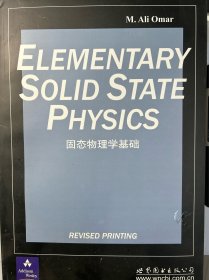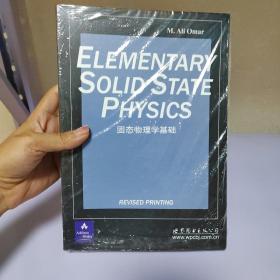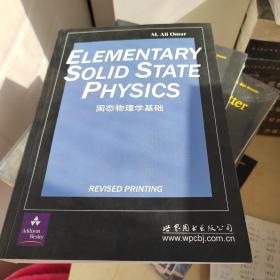
固态物理学基础
正版包邮 现货实物拍照 基本仅拆封 内页无任何笔记划线
¥ 46 5.2折 ¥ 89 全新
仅1件
北京朝阳
认证卖家担保交易快速发货售后保障
作者[美]奥马尔 著
出版社世界图书出版公司
出版时间2011-06
版次1
装帧平装
上书时间2024-02-24
- 在售商品 暂无
- 平均发货时间 7小时
- 好评率 暂无
- 最新上架
商品详情
- 品相描述:全新
图书标准信息
- 作者 [美]奥马尔 著
- 出版社 世界图书出版公司
- 出版时间 2011-06
- 版次 1
- ISBN 9787510035197
- 定价 89.00元
- 装帧 平装
- 开本 16开
- 纸张 胶版纸
- 页数 669页
- 正文语种 英语
- 【内容简介】
-
《固态物理学基础》是一部优秀的介绍固态物理学入门类书籍,也是一本很好的本科生教材。《固态物理学基础》是1975年版本的修订版,在原来的基础上做了不少改进。内容安排结构紧凑,合理,逻辑性强。尽管本书出版的比较早,但不失经典,覆盖面广,囊括了许多读者了解的话题,如,半导体设备和议题,液态晶体,聚合体和一些生物分子。大量的实用案例是本书的一大特色,更加增强了本书的可读性。目次:晶体结构和原子间作用力;x射线,中子和晶体中的电子偏移;格振动:热力学,声学和光学性质;金属ⅰ:自由电子模型;金属ⅱ:固体中的能级;半导体ⅰ:理论;半导体ⅱ:设备;电介体和固体的光学性质;磁性和磁共振;超导体;冶金学议题和固体中的缺陷;材料和固态化学;固态生物化学。附录:量子力学基础。
读者对象:物理,应用物理专业的本科生,研究生以及相关工程领域的科研人员。 - 【目录】
-
chapter1crystalstructuresandinteratomicforces
1.1introduction
1.2thecrystallinestate
1.3basicdefinitions
1.4thefourteenbravaislatticesandthesevencrystalsystems
1.5elementsofsymmetry
1.6nomenclatureofcrystaldirectionsandcrystalplanes;millerindices
1.7examplesofsimplecrystalstructures
1.8amorphoussolidsandliquids
1.9interatomicforces
1.10typesofbonding
chapter2x-ray,neutron,andelectrondiffractionincrystals
2.1introduction
2.2generationandabsorptionofx-rays
2.3bragg'slaw
2.4scatteringfromanatom
2.5scatteringfromacrystal
2.6thereciprocallatticeandx-raydiffraction
2.7thediffractionconditionandbragg'slaw
2.8scatteringfromliquids
2.9experimentaltechniques
2.10otherx-rayapplicationsinsolid-statephysics
2.11neutrondiffraction
2.12electrondiffraction
chapter3latticevibrations:thermal,acoustic,andopticalproperties
3.1introduction
3.2elasticwaves
3.3enumerationofmodes;densityofstatesofacontinuousmedium
3.4specificheat:modelsofeinsteinanddebye
3.5thephonon
3.6latticewaves
3.7densityofstatesofalattice
3.8specificheat:exacttheory
3.9thermalconductivity
3.10scatteringofx-rays,neutrons,andlightbyphonons
3.11microwaveultrasonics
3.12latticeopticalpropertiesintheinfrared
chapter4metalsi:thefree.electronmodel
4.1introduction
4.2conductionelectrons
4.3thefree-electrongas
4.4electricalconductivity
4.5electricalresistivityversustemperature
4.6heatcapacityofconductionelectrons
4.7thefermisurface
4.8electricalconductivity;effectsofthefermisurface
4.9thermalconductivityinmetals
4.10motioninamagneticfield:cyclotronresonanceandthehalleffect
4.11theacconductivityandopticalproperties
4.12thermionicemission
4.13failureofthefree-electronmodel
chapter5metalsil:energybandsinsolids
5.1introduction
5.2energyspectrainatoms,molecules,andsolids
5.3energybandsinsolids;theblochtheorem
5.4bandsymmetryink-space;brillouinzones
5.5numberofstatesintheband
5.6thenearly-free-electronmodel
5.7theenergygapandthebraggreflection
5.8thetight-bindingmodel
5.9calculationsofenergybands
5.10metals,insulators,andsemiconductors
5.11densityofstates
5.12thefermisurface
5.13velocityoftheblochelectron
5.14electrondynamicsinanelectricfield
5.15thedynamicaleffectivemass
5.16momentum,crystalmomentum,andphysicaloriginoftheeffectivemass
5.17thehole
5.18electricalconductivity
5.19electrondynamicsinamagneticfield:cyclotronresonanceandthehalleffect
5.20experimentalmethodsindeterminationofbandstructure
5.21limitofthebandtheory;metal-insulatortransition
chapter6semiconductorsi:theory
6.1introduction
6.2crystalstructureandbonding
6.3bandstructure
6.4carrierconcentration;intrinsicsemiconductors
6.5impuritystates
6.6semiconductorstatistics
6.7electricalconductivity;mobility
6.8magneticfieldeffects:cyclotronresonanceandhalleffect
6.9bandstructureofrealsemiconductors
6.10highelectricfieldandhotelectrons
6.11thegunneffect
6.12opticalproperties:absorptionprocesses
6.13photoconductivity
6.14luminescence
6.15otheropticaleffects
6.16sound-waveamplification(acoustoelectriceffect)
6.17diffusion
chapter7semiconductorsii:devices
7.1introduction
7.2thep-njunction:therectifier
7.3thep-njunction:thejunctionitself
7.4thejunctiontransistor
7.5thetunneldiode
7.6thegunndiode
7.7thesemiconductorlaser
7.8thefield-effecttransistor,thesemiconductorlamp,andotherdevices
7.9integratedcircuitsandmicroelectronics
chapter8dielectricandopticalpropertiesofsolids
8.1introduction
8.2reviewofbasicformulas
8.3thedielectricconstantandpolarizability;thelocalfield
8.4sourcesofpolarizability
8.5dipolarpolarizability
8.6dipolardispersion
8.7dipolarpolarizationinsolids
8.8ionicpolarizability
8.9electronicpolarizability
8.10piezoelectricity
8.11ferroelectricity
chapter9magnetismandmagneticresonances
9.1introductio
9.2reviewofbasicformulas
9.3magneticsusceptibility
9.4classificationofmaterials
9.5langevindiamagnetism
9.6paramagnetism
9.7magnetisminmetals
9.8ferromagnetismininsulators
9.9antiferromagnetismandferrimagnetism
9.10ferromagnetisminmetals
9.11ferromagneticdomains
9.12paramagneticresonance;themaser
9.13nuclearmagneticresonance
9.14ferromagneticresonance;spinwaves
chapter10superconductivity
10.1introduction
10.2zeroresistance
10.3perfectdiamagnetism,orthemeissnereffect
10.4thecriticalfield
10.5thermodynamicsofthesuperconductingtransition
10.6electrodynamicsofsuperconductors
10.7theoryofsuperconductivity
10.8tunnelingandthejosephsoneffect
10.9miscellaneoustopics
chapter11topicsinmetallurgyanddefectsinsolids
11.1introduction
11.2typesofimperfections
11.3vacancies
11.4diffusion
11.5metallicalloys
11.6dislocationsandthemechanicalstrengthofmetals
11.7lonicconductivity
11.8thephotographicprocess
11.9radiationdamageinsolids
chapter12materialsandsolid-statechemistry
12.1introduction
12.2amorphoussemiconductors
12.3liquidcrystals
12.4polymers
12.5nuclearmagneticresonanceinchemistry
12.6electronspinresonanceinchemistry
12.7chemicalapplicationsofthemsssbauereffect
chapter13solid.statebiophysics
13.1introduction
13.2biologicalapplicationsofdelocalizationinmolecules
13.3nucleicacids
13.4proteins
13.5miscellaneoustopics
appendixelementsofquantummechanics
a.1basicconcepts
a.2theschrsdingerequation
a.3one-dimensionalexamples
a.4theangularmomentum
a.5thehydrogenatom;multielectronatoms;periodictableoftheel
a.6perturbationtheory
a.7thehydrogenmoleculeandthecovalentbond
a.8directedbonds
index
点击展开
点击收起
相关推荐
— 没有更多了 —





















以下为对购买帮助不大的评价